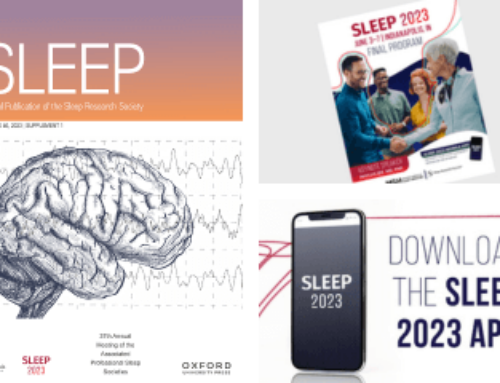WESTCHESTER, Ill. – Bad dreams in pre-schoolers are less prevalent than thought. However, when they do exist, nightmares are trait-like in nature and associated with personality characteristics measured as early as five months, according to a study published in the January 1 issue of the journal SLEEP.
The study, led by Valérie Simard, under the direction of Tore Nielsen, PhD, of the University of Montreal, sampled 987 children in the Province of Quebec, who were assessed by their parents at the 29-month, 41-month, 50-month, five-year and six-year mark. Parents were asked in a questionnaire about the frequency of their child’s bad dreams without requiring that they attempt to judge whether or not awakenings occurred.
According to the results, proportions of participants in each bad-dreams frequency category were quite stable over time. For those reporting never, proportions were as follows: 29 months, 31.4 percent; 41 months, 29 percent; 50 months, 27.7 percent; five years, 30.7 percent; and six years, 31.4 percent. Most fell into the sometimes category (29 months: 65.2 percent, 41 months; 65.5 percent; 50 months, 69.3 percent; five years, 66.4 percent; and six years, 66.3 percent), with marginal proportions in the often (29 months, 1.7 percent; 41 months, 3.9 percent; 50 months, 2.1 percent; five years, 1.8 percent; and six years, 1.3 percent) and always (29 months, 0.7 percent; 41 months, zero percent; 50 months, 0.1 percent; five years, 0.8 percent; and six years, 0.2 percent) categories.
A higher mother’s rating of the child’s anxiety at 17 months was the best of 10 psychological predictors of bad dreams at 29 months, followed by the father’s rating. Mother’s ratings of the child’s difficult temperament at five months was associated with a small, but significant, increased risk of having bad dreams at 29 months.
In addition, children with consistent bad dreams were rated by their mothers as having more difficult temperaments at five months and 17 months, as being more emotionally disturbed at 17 months and as being more anxious at 17 months than were children having no bad dreams. They were also rated by their fathers as more anxious at 17 months.
Further, compared with children having no bad dreams, those with consistent bad dreams were: (1) More frequently restless in a day at five months, (2) More likely to cry and be restless in general at five months, (3) More difficult to calm at 17 months and (4) More frequently restless in a day at 17 months.
“Little attention is paid to optimizing definitions or measures of bad dreams among the very young,” wrote the authors. “These results support the suggestion that young children who develop chronic bad dreams are similar to adult nightmare sufferers, for whom links with general distress and emotional psychopathology are well established. Carefully targeted treatments of early anxiety symptoms, as well as promotion of early, protective parental practices may thus help prevent a cascade of changes leading, over the years, to bad dreams, nightmares, and associated psychopathologies.”
Nightmares are disturbing, visual dream sequences that occur in your mind and wake you up from your sleep. Nightmares can begin at any age. They usually begin before a child reaches six years of age. About 75 percent of children recall having at least one or a few nightmares during childhood. They occur in equal rates among boys and girls. Estimates are that 10 to 50 percent of children from three to five years of age have severe nightmares that disturb their parents. Nightmares in children tend to reach a peak by 10 years of age. After that, they decrease. Some children may continue to have nightmares as teens and adults. For them it may be a lifelong problem.
It is recommended that children in pre-school sleep between 11-13 hours a night and school-aged children between 10-11 hours of sleep a night.
The American Academy of Sleep Medicine (AASM) offers some tips to help your child sleep better:
- Follow a consistent bedtime routine. Set aside 10 to 30 minutes to get your child ready to go to sleep each night.
- Establish a relaxing setting at bedtime.
- Interact with your child at bedtime. Don’t let the TV, computer or video games take your place.
- Keep your children from TV programs, movies, and video games that are not right for their age.
- Do not let your child fall asleep while being held, rocked, fed a bottle, or while nursing.
- At bedtime, do not allow your child to have foods or drinks that contain caffeine. This includes chocolate and sodas. Try not to give him or her any medicine that has a stimulant at bedtime. This includes cough medicines and decongestants.
Parents who suspect that their child might be suffering from a sleep disorder are encouraged to consult with their child’s pediatrician or a sleep specialist.
SLEEP is the official journal of the Associated Professional Sleep Societies, LLC, a joint venture of the AASM and the Sleep Research Society.
More information on “nightmares” is available from the AASM at https://www.SleepEducation.com/Disorder.aspx?id=37.
SleepEducation.com, a patient education Web site created by the AASM, provides information about various sleep disorders, the forms of treatment available, recent news on the topic of sleep, sleep studies that have been conducted and a listing of sleep facilities.
For a copy of this article, entitled, “Longitudinal study of bad dreams in preschool-aged children: prevalence, demographic correlates, risks and protective factors,” or to arrange an interview with an AASM spokesperson regarding this study, please contact Jim Arcuri, public relations coordinator, at (708) 492-0930, ext. 9317, or jarcuri@aasm.org.
# # #




